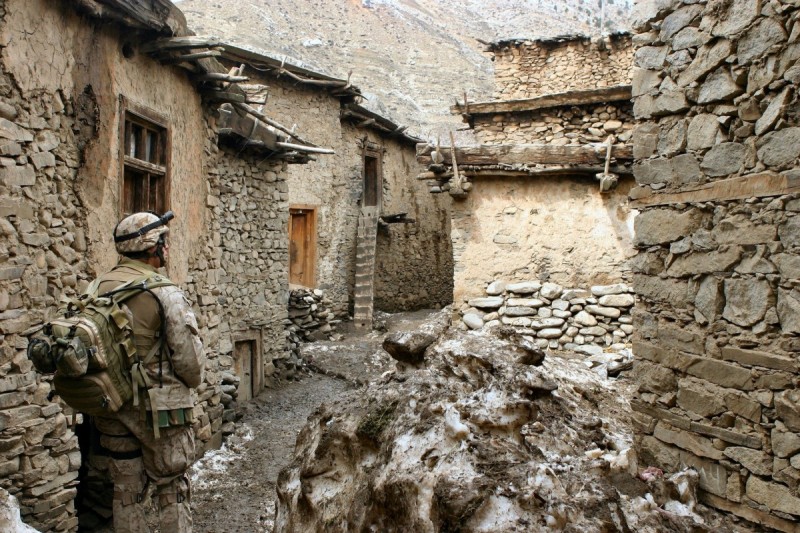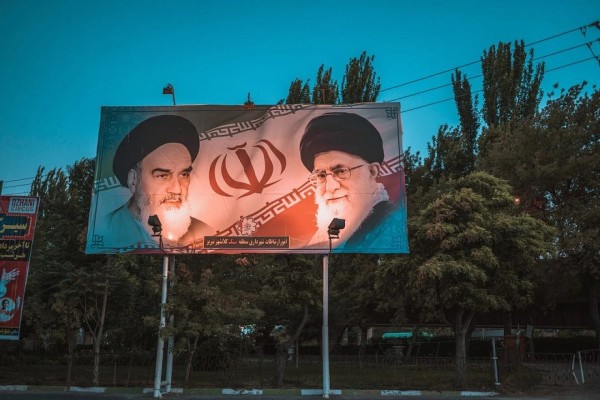Afghanistan: the myth of the good war

US Marines patrol a village in Parwan province, Afghanistan, July 10, 2015. Photo from Pixabay
Now in its eighth year, the US and NATO occupation of Afghanistan continues to grind on, its original—if entirely spurious—raison d’etre long since lost in the fog of war.
Having thus ostensibly started out as a campaign to root out the personification of evil incarnate (i.e. Osama bin Laden), the ‘mission’ then quickly transmogrified into ‘regime change’ and thence into the typical imperial project of ‘bringing peace and democracy to the heathens.’
The latter, it need hardly be said, has been practiced many times before. In Indo-China during the Vietnam War, for instance, some four million or so were killed to save them from themselves. Many hundreds of thousands more were subsequently killed in Latin America to save them from themselves. And, of course, more recently in Iraq, over a million have now been killed since 2003 (adding to a previous million or two) to save them from themselves.
If anything should be clear to homo-imperialis it is that our magnanimity and our sacrifice know no bounds; exceeded, perhaps, only by the ingratitude of those we seek to help. But then, someone has to care. And, oh, how we care.
Loving them to death
Of all the paper-thin rationales, then, for the continuing occupation of Afghanistan, the notion that ‘we’ are somehow deeply concerned for the welfare of the Afghani people is the most stubbornly, the most patently delusional.
This is not to say that the average Canadian may not harbour some vague feelings in this regard. Indeed, such sentiments–heavily infected by a barely submerged imperial hubris though they invariably are–are precisely the target of state propaganda. The question then is not whether the ‘man inthe street’ evinces such feelings, but, first, whether they are supported by the actual facts on the ground and, second, whether these have any relation whatsoever to the actual function of the occupation within the state’s economic, political and geo-strategic calculus. Let us take a brief look at both of these.
As I remarked in an earlier essay (May, 2007) the response, of Western reporters and TV news personnel to the initial invasion of Afghanistan resembled nothing so much as that, ‘of morally deficient children lauding the annihilation of insects.’ Thus, an unmistakable hint of ‘glee’ attended the ensuing military carnage as possibly tens of thousands of Afghans (not yet ‘insurgents’) were killed outright. Follow-up massacres by US and allied forces of thousands of Taliban prisoners at Kunduz and Mazar-i-Sharif were quickly swept under the carpet as all eyes avidly focused on the unfolding of the great moral play.
In the aftermath of the initial ‘pacification’ of the country the usual colonial machinations were deployed. By late 2002, the Trans-Afghan Pipeline deal had been signed. All that was necessary now was to stabilize the country. Hamid Karzai, an ex-California oil executive was installed, via rigged elections, as puppet ruler. He was assisted by a gaggle of MPs composed of drug bosses and feudal lords most of whom were granted political immunity from all manner of former war crimes. Ministry positions were awarded as spoils of war to the various Tajek, Uzbek and Hazari generals who had weighed in against the clergy and the Taliban (comprised mainly of Pashtuns). Essentially, a group of authoritarian, theocratic warlords (the Taliban) not favourably disposed to playing ball with the new colonial master, got replaced by another group of authoritarian, theocratic warlords (the Northern Alliance) who were.
Not surprisingly, given the motives involved, the whole governmental edifice was permeated from the beginning–and as it is to this day–with extortion, graft, patronage and violence. What little foreign aid, for instance, leaks out of the circular loop from Western government coffers to Western corporate vaults and into Afghanistan proper (approximately 86 cents of every US ‘aid’ dollar is ‘phantom’, and never shows up in the recipient country) is then sopped up by the extensive corruption. Almost none of it reaches the Afghan people most in need.
And, of course, if the country now reeks with the odour of a giant mafia enterprise, this is not some peculiar aberration, but the inevitable and predicable outcome of its role as a client state functioning within an imperial framework.
Women’s rights have expanded, but only theoretically. In practice they are as bad as they ever were under the Taliban except that the former more or less guaranteed a minimum security for women. Instead, rape is now endemic and hundreds of young women and girls have immolated themselves rather than face the forced marriages for money that have become part and parcel of the general culture of corruption and violence.
Still, likely the most irritating bur under the saddle of the average Afghani is the large number of civilian casualties that result from the US air campaign. For while it is true that many Afghan civilians (approximately half) are killed either directly by Taliban suicide attacks against Western targets or as a result of Taliban forces taking cover amidst the civilian population, the other half are killed by US air strikes whose clear strategic calculus is the security of American troops at the expense of Afghan civilians. Ever since Vietnam, American politicians have understood that too many troops killed in actual battle is a public relations nightmare. The Pentagon’s strategy has therefore consisted, both in Iraq and in Afghanistan, of deploying ground troops only as means of drawing out enemy forces which can then be conveniently pulverized from the air.
It is in respect of this strategy, by the way, that one often hears in the Western media the moronic argument to the effect that the Taliban are ‘cowards’ hiding behind civilian ‘shields’; as if congregating in an open field armed only with their rifles, and engaging our brave lads sheathed in their body armour, their tanks, and swooping down in their invulnerable F-18s would represent some sort of fair fight.
The Afghani people, however, seem a tad more savvy than the average Western journalist and have, instead, taken to perceiving the civilian casualties caused by the NATO forces as morally worse than those caused by the Taliban. This because they judge NATO tactics as both cowardly and as a transparent indication that the West values the lives of its soldiers far more highly than it does the lives of Afghan civilians.
And, truth to tell, we do. Anyone who thinks differently need only reflect upon the media coverage given to the 100+ Canadian troops killed in Afghanistan over the past seven years, with the coverage given, say, to the 95 civilians (including 50 children and 19 women) who were killed in the province of Herat last August 22 in just one single NATO air strike.
Still, I reckon one has to break a few eggs to save people from themselves. We break a couple of thousand a year. Not counting, naturally, enemy casualties, who register on no tally sheet whatsoever.
A rare bird?
That any of the foregoing can be thought of as some sort of aberration from intended policy, or some tragic if necessary by-product of a noble enterprise is to have missed the entire thrust of imperial history over the last several thousand years. More to the point, it is to have missed the fact the whole point of the ‘mission’ in Afghanistan is simply the occupation itself. As such, Afghanistan is a vital piece of real estate. How vital?
First, Afghanistan represents a crucial conduit for the future transport of Caspian Sea oil and gas through to the Arabian Sea. This oil and gas is seen as enormously important in an age of general fossil fuel decline (peak oil) particularly in view of the fact that Caspian deposits are relatively untapped and thus represent a vast potential for a rapid expansion of output. Pipelines have already been built heading east from the Caspian through the Caucasus and Turkey, but the need for a supply route through to the markets in India and Asia has long been considered paramount.
Second, Russia and China are America’s chief military and political rivals, though inter-imperialist economic rivalry places Europe in the ‘enemy’ column as well. Controlling the world’s Mid-East and Central Asian oil supplies is, then, central to the American imperium in a era when US economic power is clearly on the wane. The American ruling class are only too aware of the latter fact and consequently have sought to do what virtually every empire before them has done in similar situations, i.e. embark on a project of military expansionism in the desperate attempt to offset economic decline. After all, Washington may be losing its economic clout, but it retains a military machine the likes of which the world has never before witnessed. The danger, bye-the-bye, that this wounded-bear phenomenon represents to the entire globe cannot be overstated.
Third, the projection of power into Central Asia is not just about oil, but about strategic military positioning itself. The US already occupies Iraq and Afghanistan, is allied with Pakistan (tenuous though this is at the moment), India, and Indonesia. In addition, it would like to take Iran back into the fold, and the fact that Iraq and Afghanistan flank it on both sides is no accident. Most of the former Warsaw Pact countries are now either in NATO or are awaiting membership. Many of the rest of the former Soviet/Islamic states that lie just above Afghanistan are presently subject to a tense turf war between Russia and the US. Russia, in other words is surrounded, as is China (by Taiwan, Japan, the Philippines, all US client states).
Fourth, Afghanistan itself is a mineral treasure trove hosting as it does vast deposits of gold, uranium, copper, coal–even oil and gas. It also is one of the few places on earth with significant deposits of tantalum, a rare element essential in the manufacture of cell phones and computers. [Indeed, the Western scramble for tantalum (amongst other minerals) has been a prime driver of the recent killing fields in the Congo.] Canadian mining companies along with American, British, Russian and Chinese are thus set to make, to coin an apt phrase, a killing in Afghanistan.
The notion, then—widely espoused even amongst ‘progressive’ thinker—that somehow the ‘mission’ can, nonetheless, perhaps be redirected towards humanitarian ends flies directly in the face of the granite fact of the mission’s fundamental and true aim, i.e. unending colonial occupation and exploitation (to this purpose, Washington forced Karzai, in 2005, to sign a ‘declaration of strategic partnership’ which gave the US the right to a permanent military presence in the country).
Finally, and all Obama-mania aside, the new US Administration is not only sending in 17,000 more troops to ‘pacify’ the country, but has just issued a new court ruling making ‘enemy combatant’ status (i.e. no legal rights at all) the name of the game for all captured forces in Afghanistan. For the 600 prisoners now incarcerated in Khandahar there is no recourse to any system of, well, no recourse at all, ever.
A ‘good war’ is likely an oxymoron, but if there ever was such a rare bird, this certainly ain’t one of ‘em.
Antony C. Black is a freelance journalist.










